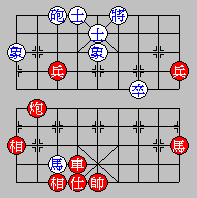I have conceived the following algorithm for ruling repetitions, in an attempt to replicate Asian rules:
- Code: Select all
Defined order: R > c,H > A,E,Q
clear preyStack;
for(all positions p with white to move within repeat loop)
clear chaseStack;
for(all white moves m from position p+1)
if(move m is non-capture) continue;
if(m moves K or P) continue; // K and P are allowed to chase
if(m captures a P that has not crossed the river)
continue; // chasing of non-crossed Pawns is allowed
push move on chaseStack;
// the chaseStack now contains all captures with A, E, H, R or C.
for(all white moves m from position p)
if(moving piece was piece that was moved in p in the repeat loop)
correct fromSquare of move to position of piece in p+1;
// (If we keep attacking with same piece, it is no chase)
if(move m occurs in chaseStack)
delete move m from chaseStack;
// chasestack now contains only the captures newly created by the move
for(all moves m on chaceStack)
if(victim == attacker)
if(victim x attacker is legal move in position p+1)
delete move from chaseStack; // sacrifice is not a chase
continue;
if(victim > attacker) continue; // LxH is always chase
perform move m from position p+1 to create position q;
if(black can recapture on same square in position q)
delete move m from chaseStack;
// chaseStack now only contains true chases
if(first iteration) copy toSquares of moves on chaseStack to preyStack;
for(every move m on chaseStack)
find first occurrence i of the toSquare of m on preyStack;
move this occurrence i towards bottom of preyStack;
pop the top entries off preyStack;
//preyStack now contains (location of) all black pieces chased on every move so far
for(all squares s in preyStack)
if(s is fromSquare of black move m played from p+1 in loop)
adjust s to the toSquare of m;
// preyStack contains all black pieces that where perpetually chased
if(preyStack not empty) white is perpetually chasing;
Repeat the same procedure with reversed colors;
if(none or both are chasing) rule draw; else
if(white is chasing) rule win for black; else
if(black is chasing) rule win for white;
I hope that someone familiar with Asian rules could have a look at this pseudo-code, to see if this indeed correctly reproduces Asian rules.

